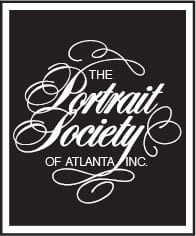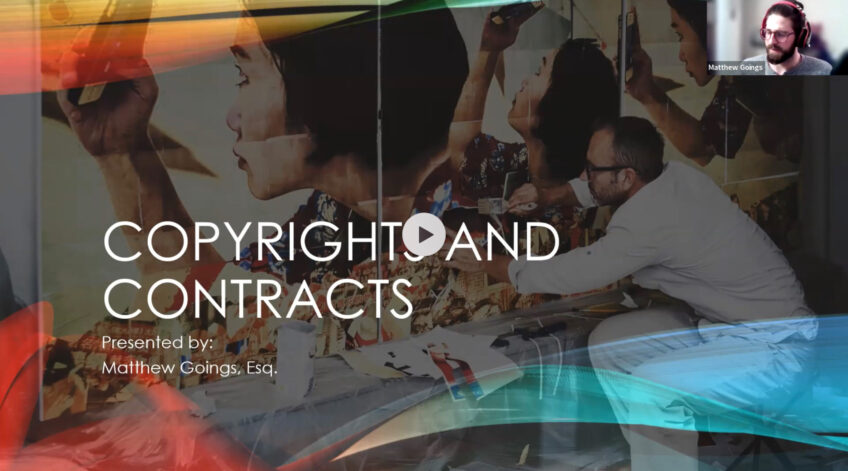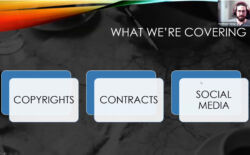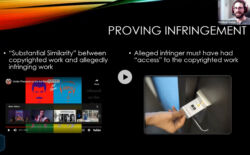Essential Knowledge for Artists
By Ashley Hawkins Stewart
February 16, 2022
Most artists don’t think much about legal matters. I know I just create and share and expect the best from others. If you are anything like me, you never thought about who owned an image on social media.

As it turns out, there is quite a bit that we all should know. The Portrait Society of Atlanta recently welcomed Matthew Goings, Esq., an Atlanta–based business startup attorney (formerly Director of Operations for Georgia Lawyers for the Arts). Mr. Goings presented a comprehensive summary of the law surrounding intellectual property and creativity via Zoom meeting on February 15, 2022.
Intellectual property is, in a broad sense, a creation of the mind. Those creations are then further defined to protect the creator. Copyrights protect anything creative — like movies, music, poetry, and art.Trademarks are meant to protect branding. Patents apply to something industrial or useful. And finally trade secrets protect a process that has value in the secret itself, like KFC herbs and spices.
Article 1 section 8 of the Constitution actually addresses intellectual property.
“To promote the Progress of Science and useful Arts, by securing for limited Times to Authors and Inventors the exclusive Right to their respective Writings and Discoveries”
Which is to say that the creator of a work has a limited duration monopoly on said work.
In order to be copyrightable, work has to meet four standards: 1) It is original; 2) It has a work of authorship; 3) It is fixed; and 4) It is in a tangible medium.
Original means original to you and not copied from someone else. Furthermore it means that the work contains a modicum of creativity. If the work is a simple compilation of information like the phone book, it is not copyrightable. A work of authorship—at least in the United States—means it is a product of a human being. That is if your dog accidentally snaps a photo, it is not copyrightable. Fixed means the work exists for more than a transitory time. That time can be as low as a few seconds, but it can’t be instantaneous. Lastly work must exist in a tangible (touchable) medium. This extends to items stored in the Cloud as somewhere that data is physically kept in a room.
With those definitions in mind, Mr. Goings listed some items that were copyrightable. Anything written ranging from poetry to software, dramatic works, choreography, pictorial works including graphic design and sculpture, motion pictures, architecture and sound recordings are all copyrightable. Things that are not copyrightable include ideas and production methods, titles, names, phrases, slogans, improvisations, work that is all information without creative process (i.e., writing about Abraham Lincoln’s life), and works by the US Government.
So now that we know what is copyrightable, who owns that copyright? From the moment it is put into fixed form it belongs to the author for a term of that author’s life plus 70 years. If it was a collaboration, it belongs to all collaborators for a term until the last collaborator’s life ends plus 70 years. Having a copyright gives one the ability to reproduce the work, display it in public, make derivative or adaptive works (sequels), and distribute the work.
Conversely, a person who does not own an image cannot make derivative work from it. A recent famous example was that of the Obama “Hope” poster, which was created by Shepherd Fairey from a photograph which was copyrighted by the AP. This resulted in a lawsuit and out of court settlement for damages.
The second portion of the lecture dealt with contracts. Three elements are required for a valid contract: offer, acceptance, and consideration.
An offer is a promise that one party makes in exchange for another party’s performance or payment. In order for a contract to be enforceable, the object or service being sold cannot be illegal. Assuming that it is legal, acceptance depends on the receiving party understanding that there is an offer, and knowing what that offer is. There can be no acceptance without an understanding of the offer. Also there can be no duress when accepting the offer. If a counter offer is made, the original offer is invalidated. If the seller rejects a counter offer, the seller must re-make the original offer. Which brings us to consideration, which lays out the benefit that each party is receiving from the deal. This too must be legal, i.e. no one can contractually barter services for illegal drugs. And although verbal contracts are valid in some places, its always best to have it in writing—even if the contract consists of two sentences on the back of an envelope!
Liscensing is a type of contract. In this special kind of contract , the licensee is granted very specific uses of a copyrighted product by the owner of the copyright. It should specify whether exclusive or non-exclusive, why, what rights exactly and in what territory the rights are granted. Furthermore the obligations of both parties should be delineated and the term of the contract clarified. Payment for licensing must be clear, as should the methods of termination.
Mr. Goings’ presentation contained a wealth of vital information for any artist. Concise and understandable by lay people it is a necessary first step to navigating the often murky water of the business of art.
The presentation is currently available to members only on the Portrait Society of Atlanta YouTube page.
___________________________________________________________________________________________
Matthew Goings of Goings Legal, LLC can be reached through Discovery Call or email: matthew@goingslegal.com. Find his website at: goingslegal.com





